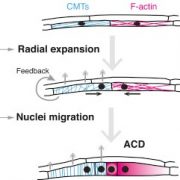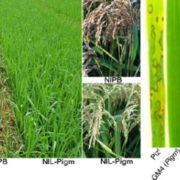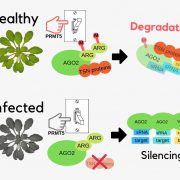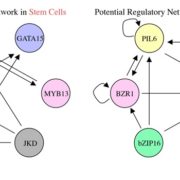Combining Forces for Hypocotyl Elongation: Histone Modifications, GA, and the Circadian Clock
Zheng et al. discover proteins that mediate interactions between gibberellins and the circadian clock https://doi.org/10.1105/tpc.17.00830
By Han Zheng and Yong Ding
Background: Hypocotyl elongation helps the shoot emerge from the soil surface. The gibberellin (GA) signaling protein RGA inhibits hypocotyl elongation, whereas activity of the circadian clock protein CCA1 promotes hypocotyl development. Multiple signaling pathways are integrated with GA signaling to regulate plant development.
Question: Hypocotyl elongation is controlled by phytohormones and the circadian clock. How are these processes integrated? Are there any other key regulators in hypocotyl elongation besides GAs and the circadian clock?
Findings: We found that RGA interacts with the CCA1 pathway. CCA1 promotes hypocotyl elongation via binding to DWF4 to promote and enhances its transcription, whereas RGA reduces CCA1 binding to DWF4, a gene that plays a key role in cell expansion. MLK1 and MLK2, which are responsible for histone phosphorylation, positively regulate hypocotyl elongation. MLK1 and MLK2 interact with RGA and CCA1. MLK1 and MLK2 enhance DWF4 transcription by reversing the inhibition by RGA, resulted in the promotion of hypocotyl elongation.
Next step: A variety of regulatory pathways form a complex regulatory network that precisely controls plant growth. Further investigation into the interaction of different signaling pathways is needed. In addition, it is unclear how phytohormone signaling is integrated with histone modifications.
Zheng H, Zhang F, Wang S, Su Y, Liu Y, Jiang P, Chen R, Ji X, Ding Y. (2017). MLK1 and MLK2 coordinate RGA and CCA1 activity to regulate hypocotyl elongation in Arabidopsis thaliana. Plant Cell. 30: 67-82 https://doi.org/10.1105/tpc.17.00830










